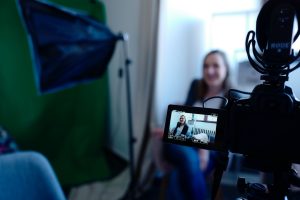Interviews are an essential part of digital communications, whether internal or external. However, speaking on camera is a difficult exercise. If you’re aware that the interview is an essential tool in your digital communications, but don’t know where to start, this article inspired by our latest Masterclass Express is for you. You’ll discover key strategies and techniques for engaging your audience.
Storytelling
Storytelling is the key to engaging your audience. Good storytelling isn’t just about presenting facts; it’s about weaving them into a narrative that resonates with the listener. By incorporating personal elements, anecdotes or inspiring examples, you create an emotional connection, making your speech both more effective and more memorable.
The power of anecdotes
Personal anecdotes create an emotional connection with your audience, making your message more accessible and easier for them to identify with. Choose anecdotes that reinforce your main message and are appropriate for your target audience.
Take the example of a general manager sharing his team’s achievements. Rather than simply listing statistics, he tells how his staff overcame specific challenges, and highlights their perseverance and creativity. This story has the advantage of conveying information, inspiring and motivating at the same time.
What’s more, anecdotes gain in power when they are visual. For example, instead of simply talking about the success of a project, describe the meeting room buzzing with enthusiasm or the look of satisfaction on the team’s faces. This makes your story more lively and engaging.
Be careful, however, not to overdo it. It’s crucial to strike a balance between professionalism and personalization, sharing your experiences and those of your team in an appropriate and measured way. The art of the anecdote, combined with a clear and engaging presentation, transforms your interventions into memorable and meaningful moments for your audience.

The story you want to tell
Preparation also includes structuring your speech, by asking yourself a few key questions: what story are you trying to tell through this interview? What message do you want to get across? If you’re not sure where to start to find the story that fits your message, remember that a story always has a beginning, a middle and an end. For example, start by setting the context, followed by a challenge or problem, and conclude with the solution or outcome. This narrative structure helps to create a coherent and captivating story.
Whether your interview is aimed at attracting new talent, motivating your teams, or managing a crisis situation, identifying your objective helps define the story the interview needs to tell. It’s always useful to know numbers and statistics, but it’s the story that counts when you want to get a message across.
Know your subject inside out
It may seem obvious, but thorough preparation is the first step to successful speaking. It takes the anxiety out of speaking, and knowing your subject inside out gives you confidence and credibility. Understanding your audience’s expectations and interests enables you to tailor your message appropriately.
Body language, intonation and pauses
When speaking, whether filmed or not, voice intonation and the strategic use of pauses play just as important a role as the content of the speech itself. These non-verbal elements can reinforce your message, captivate the audience and make your speech more dynamic and persuasive.
Body language, posture and gestures
Adopt an open, confident posture. Stand up straight without being rigid. Use gestures to emphasize your points. Natural, measured hand movements can add expressiveness to your speech. Avoid nervous movements or tics that can be distracting.
Eye contact
Even in front of a camera, imagine you’re talking to a real person. This will help create a sense of connection with your audience. Look directly into the lens from time to time, as if you were searching for your interlocutor’s gaze.
Intonation
Vary your tone to maintain interest. A monotone voice can discourage listening.
Emphasize key words and change your flow to emphasize certain parts of your speech.
Don’t hesitate to practice before the interview! You can do diction and breathing exercises to improve the clarity and range of your voice, or record yourself. When you listen to yourself again, you’ll be able to identify where you can improve.
The art of pausing
Use pauses to give your audience time to digest important information. A well-placed pause can also be used to create suspense or emphasize a crucial point. Practice your speeches with intentional pauses. This can help structure your presentation and keep your audience engaged.

Impeccable aesthetics
The visual aesthetics of your on-camera presentation are a decisive factor in the success of your communication. Poor image quality, bad lighting or inappropriate staging can distract your audience and diminish the impact of your message. High-quality video production, on the other hand, can considerably increase the engagement and credibility of your speech. Attractive visuals reinforce your message and keep your audience’s attention.
Choosing the right video production agency
Choosing the right video production agency is crucial to ensuring that your visual aesthetics live up to your expectations. Opt for an experienced agency, checking that its style and previous achievements align with your vision. It’s crucial to communicate your objectives effectively and remain open to the creative ideas proposed by the agency, while ensuring that the core message remains true to your intentions. Plan review stages carefully and adjust as necessary to ensure that the end result reflects your standards of quality and efficiency.
By choosing the right video production agency and paying careful attention to visual aesthetics, you can create on-camera speeches that leave a lasting impression on your audience. With Digital Video, you have a dedicated partner to create interviews that capture the essence of your message and convey it effectively.
Call on our expertise to transform your interviews into moving, inspiring and effective stories.

